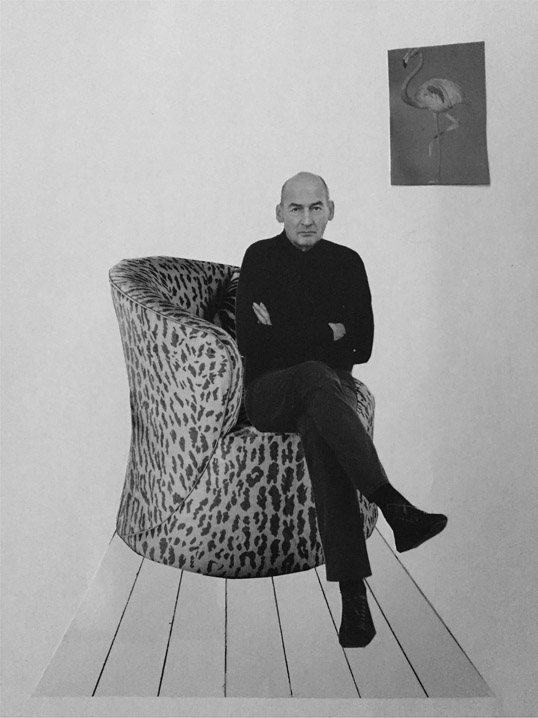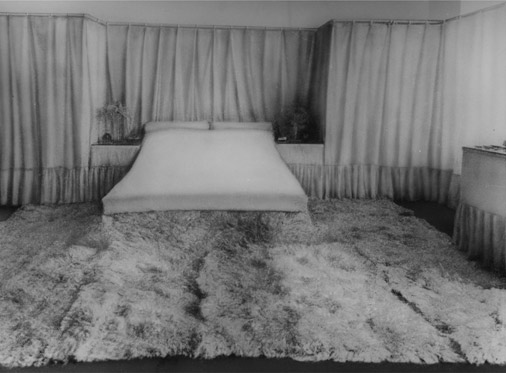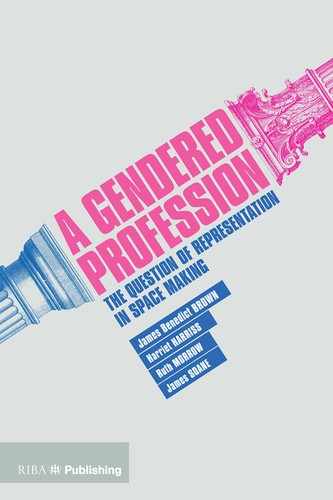Beyond Binaries1
The field of interiors is complex. Marginalised within critical discourse and historically assigned as female, the study and practice of interiors are often viewed as soft and insubstantial, politely addressing the inhabitation of space without troubling the permanence of architecture. Where architecture exerts confidence (arrogance even) in its singular projection of self, the interior is persistently dialogic, functioning under the radar or within disciplinary boundaries that operate as a one-way electric fence: architects think they can be interior designers too, but never the other way around. In the UK, RIBA certainly has no interest in acknowledging the autonomy of the interior, and the ‘professional’ bodies that align themselves with the Interior Design Industry remain unconcerned for its academic status and intellectual health.2 In a world where building anew is an increasingly rare occurrence3 the adaptive reuse of the ‘existing’ means that architects themselves are not only forced to operate in a post-architecture world, but also recognise the value of doing so.
As co-authors, our experience of the interior can be framed through both the academic institution and practice, straddling the discourses of interiors and architecture, studio and historical/critical studies. In our view, not much has shifted in terms of the perception of interiors during the past decade and more.4 If anything, public understanding of the discipline remains confused by media’s conflation of interior design and decoration, and the assumption that its practice is entirely domestic – constrained within the building envelope, untroubled by external political and cultural discourses. But if domestic space confines the interior designer, why does it liberate the architect? In Beatriz Colomina’s analysis of ‘the playboy interior’, she asserts: ‘Playboy is produced in a radical interior and is devoted to the interior, devoted like a lover.’5 For the (male) architect, designing the home is a utopian dream – the place of absolute freedom and of control – and, in the case of Hugh Heffner’s Playboy mansion, a heterotopic environment where the bed is both the workspace as well as a symbol of real and imagined sexual conquest. This is not ‘home’ as a domestic environment, framing the everyday through ‘women’s work’, but home as a landscape of entertainment clothed in sensuous surfaces and materials, designed to entrap the female prey.6 It is our contention that the home only becomes ‘domestic’ space when women make it.
Our aim here is to argue for the interior as female – and to view this as a powerful position rather than an inferior one. Further, we will speculate upon how the discourse and practice of interiors might facilitate a shift in gender relations within the academy and the built environment. To date, the gender debate has focused almost exclusively on the significance of the paucity of women architects in practice, without questioning the way in which interior design inversely mirrors this inequality.7 Professionally, interior design remains behind the eight ball,8 failing to challenge the gender biases within architecture and the construction industry at large, but more significantly unable to deal with the problem on the inside: namely, how to simultaneously redress the gender imbalance while also arguing for a practice and discourse that celebrates its feminine strengths.
Institutionally, UK schools still run almost all-female interiors courses – which, if anything, have become more female in the last decade.9 They apply and we recruit. Although more men than women lead interiors programmes, this has failed to attract more men to the field.10 Further, we have observed that a lot of energy gets expended over whether to use the term interior design, interior architecture, spatial design, and so on. Lucinda Kaukas Havenhand in her enlightening essay ‘A View From the Margin’ describes this as, ‘A futile game of “passing”. This strategy, like that of the early feminists, also assumes a kind of androgyny, and therefore the inherent link between the feminine and interior design remains unbroken’, continuing to confine the interior ‘to its supplemental position’.11
In his recent overview of the gender (im)balance in the study of interiors, Mark Gower speculates as to why this might be. ‘Interior design… has a paradoxical relationship with architecture. Some see the three years it takes to study interior design as an easier option than studying architecture, and others are attracted by the perceived seriousness of architecture and the recognition you receive.’12 Gower points to the absence of professionalisation as a significant factor, further suggesting that gender stereotypes are being reinforced prior to course selection at higher education level, and proposing that the institutions themselves need to do more to market the discipline. Certainly the popular version of interior design practice that proliferates through the media does little to rectify the misappropriation of the term.13

Domesticated, Naomi House, 2016
One of the obstacles for a discussion about gender inequality in the profession is the automatic default within existing discourse towards partitioning our analyses through the lens of the male/female binary. The risk here is both oversimplification and alienation, blaming biology rather than ideology for differences and disparities. While the interior might be more female,14 this doesn’t automatically mean its practice is necessarily more feminine or even feminist. Duality only concerns itself with who is dominant and leaves too many details unchallenged. When this happens, myths and stereotypes are easily perpetuated.
Yet if we accept that the gender biases attached to interior design are largely responsible for its inherent assignations of inferiority and otherness, then why do so many women choose it? For some commentators, the ongoing marginalisation of the interior within critical discourse as well as its perceived inferiority as practice has historically rendered the interior as other. Situated on the margin, the interior has offered women a hidden place, or perhaps a ‘safe house’, within which to shape and construct their identities – identities that have been largely connected into the experience and commodification of everyday life. Of course, we can view the ‘othering’ of the interior as a disadvantage – not least because we’ve been societally conditioned to do this – but shouldn’t we see it as an asset? Hasn’t its marginalisation served to enrich and even advantage the interior as a discourse and practice? The academic Henry Hildebrandt suggests that, ‘[I]nterior design is grounded in the condition of additive assemblies and separate contracted services. While the design processes of architecture and interior design share the same procedural sequence and core discipline vocabulary, interior design, both as a discipline and its product is (or can be) free of the weight of the architecture.’15 Rather than driving the distinction between architecture and interiors through typologies of space, it is perhaps useful to envisage it as a deliberate strategy. In our view, interiors is more than a trade or a tradition, but better understood as a tactic: one through which gender and its representation in the design industry can be understood differently.16
As a tactic the discourse and practice of the interior needs to inhabit the margin productively, using it as a space from which to employ ‘women’s ways of knowing’.17 Kaukas Havenhand writes that, ‘Design processes undertaken in this feminist perspective are likely to blur role distinctions between designer and client, and designer and user; make closer spatial or visual connections between spaces; integrate diverse kinds of spaces; and combine both subjective and objective information.’18 These ‘ways of knowing’ contemplate a professional world where the practice of the interior might remodel the binary to effect a shift in power.
Interiors does not need to be architecture’s girlfriend in order to succeed. Remodelling the binary does not mean that interior design should get into bed with architecture in order to become as one. While Gower advocates professionalisation as a means to achieve equality with architecture, the question arises as to whether professionalisation enforces the gender partition.19 On this basis, we advocate that the practice of interiors avoid concerning itself with professional constraints and instead enjoy greater critical freedoms, remaining more instinctually driven and adept at experimentation and managing ambiguity. Indeed, the price of professionalism is protectionism. Far better to be porous and playful, slipping between disciplines, expansionist in our aspiration. Since we’re increasingly going to be building less and reusing more, the power balance between interiors and architecture will inevitably shift. What remains to be seen is how these market driven changes impact upon otherwise hermetic imbalances.20
Dolls House

Prisca Thielmann’s ‘Luftschloss’: If wall-decoration was structural, 2008
Since gender partitioning preceded the professionalisation of space, what else can account for how we got here? Historically, the interior has been conflated with the body, in particular the female body. Further, if we position the home as, ‘the epitome of interiority, based around changing concepts of relative privacy, intimacy, identity and, particularly, gender’,22 then it is clear that understanding the interior as female is an idea embedded within existing socio/cultural frameworks and discourse – whether we like it or not. Subsequently, many interiors theorists have sought to explain why and how interiors are automatically viewed as female.
Kaukas Havenhand grapples with the origins of the perception of the interior as female and inferior. Citing ‘degeneration theory’ – which contends that how we might reorganise ourselves societally might then alter us biologically – she accounts for why: ‘The feminine represented the primitive, base, and erotic urges of society that had to be suppressed in order for society to evolve and progress rationally. All indications of the feminine, therefore, were perceived as inferior.’23 Not only does degeneration theory place the feminine at the margins of society, it constrains it there within the domain of the private, the domestic, the maternal, and the erotic.
This suppression of the feminine within cultural discourse was powerfully deconstructed by Laura Mulvey in her 1975 essay ‘Visual Pleasure and Narrative Cinema’.24 Here Mulvey introduced the concept of the ‘male gaze’ as a particular feature of the gender/power dialectic in film: the gaze operating as a voyeuristic device that fetishises the female body and corrupts it. This dialectic continued to reveal itself within the production and consumption of the interior throughout the late 19th and into the 20th century. In her analysis of the Austrian architect Adolf Loos’s Müller and Möller Houses, Beatriz Colomina describes the experience of being inside a Loosian space: ‘Upon entering a Loos interior one’s body is continually turned around to face the space one just moved through, rather than the upcoming space or the space outside. With each turn and each return look, the body is arrested.’25 Loos’s architecture contrives the ‘Theatre Box’ as a specific motif; a space that Colomina suggests is ‘marked as female’ – protective and attention seeking – ‘in framing the view, the theatre box also frames the viewer’26 and therefore the gaze.
This concept is exemplified in Loos’s house for the dancer and performer Josephine Baker. Unlike his other work it is not designed to accommodate the theatre of everyday life but rather to frame Baker herself, placing her inside the inside as an objectified commodity. The use of light and glazing in the interior both impede Baker’s ‘sight’ of the viewing subject beyond the pool and operate as a mirror reflecting her body back on herself – a composition of both the voyeuristic and the narcissistic gaze. Here the very surfaces of the interior are fetishised, and Baker’s body is made available for visual consumption.

Lina Loos’s bedroom
The epitome of this conflation of the interior with the female body is seen in Lina Loos’s bedroom. The photographs of this space depict a bed draped in animal skin, blurring the separation of interior surface and domestic object. Loosian architecture is an architecture of pleasure that clothes the body, enveloping and wrapping it. Where the exterior of a house is masculine and operates as a mask that protects and conceals the inside, the interior is female, sexual, and the site of reproduction – a binary division that Colomina describes as gender loaded.
These versions of the interior as female situate the user as secondary to the architecture. Here the binary reduces the characteristics of femininity to decorative function – marginalised and without voice. Our view is that this space can be subverted and reclaimed. As feminist and activist bell hooks suggests, the power of the margin is as a ‘space of radical openness’ and a ‘site of creativity and power’,27 and while the conflation of the interior with the female body has served to render it as virtually invisible within architectural discourse, we are arguing here for its expansion. In a narrative of the interior as domesticated and controlled, we propose the practice of interiors as a reframing of this binary. Let’s keep the interior female.

Juno tackles the interior, courtesy of Lou Fletcher
You’ll Get Dirty Doing That
The ongoing assumption that the interior is simply the product of the commercialisation and commodification of domestic housekeeping, and an approved outlet for a suitably ‘feminine’ self-expression, has ultimately transmogrified the interior into another capitalist market opportunity.28 Capitalism has, in effect, transformed the ‘amateur’ domestic activities such as cooking, childcare, cleaning, and maintenance of the home into a professional activity29 as a means of monetising them. However, in today’s practice environment, interior designers are more often working on commercial, retail, workspace, and even ‘infrastructure’ projects than domestic ones.30 Penny Sparke and John Potvin have both examined how the practice of interior design has shifted from the domestic discipline of decoration towards an architectural endeavour represented through the ‘total work of art’.31 Within modernist discourse, the design and furnishing of the interior was very much seen as an extension of the grand architectural narrative, or what Viennese architect Ernesto Rogers described as the ability to design everything ‘from the spoon to the city’.32 Potvin also suggests that, like fashion, interior design developed as a profession in parallel with the ‘formulation of modern (bourgeois) identity’.33 So for Potvin, both interior design and fashion design operate ‘as interstitial modalities of identity formation and subject actualisation’.34 Perhaps the appeal of the quest for an original (as opposed to the uniformity of a professional) identity explains why fashion is roughly as female-dominated as interiors. By keeping interiors free of constraints, regardless of the fact that interior designers now have the option to become ‘professionals’, maintains and promotes female hegemony over the margin as a spatial typology. Subsequently, the embedding of the interior as a feminine space and practice since the middle of the 19th century – a critical moment when the spheres of public and private life became distinct – ‘has been useful both as a way of understanding an ideology of gender operating in the past, and as an analytical tool in 20th century history writing’.35 As fashion theorist Elizabeth Wilson explains, conflating ‘anti-sexism with anti-sex’ leaves only two choices: either an unequivocal condemnation of every aspect of culture that reproduces sexist ideas of women and femininity, or a more popular ‘liberalist’ view that uses women’s participation to justify its acceptability.36 While we support the right of interiors to be female, we argue that there are more than two ways of operating within the field. Interior practice requires emotional intelligence – an ability to read both buildings and people, to mediate across and between them. And not all interior design interventions are either additive or benign – interior design also undresses architecture, taking it apart before putting it back together again, reconfiguring it anew.37

Feminist Gym. MA Interior Design Project, Lucy Sanderson, 2016
Fossick and Fling, Facing Uncertainty
Much of the current emphasis in interior design practice celebrates the appropriation and renewal of the built fabric as a commercial venture (or ‘altering architecture’ as Fred Scott39 calls it): the practice of adaptive reuse commodified rather than philosophised. As part of our research for this chapter, we launched a questionnaire on interior design via our student and professional networks. Perhaps indicatively, no two responses to any one question about why people choose interior design, as either a programme of study and/or as a profession, were the same, suggesting its potential is more multifarious than is perhaps assumed. As one respondent explained, his attraction to the field was predicated upon the conviction that the built environment project is complete. Now there are only processes and cultures of how we reconfigure it. In applying this thinking to the current gender question that this book is committed to examining, we propose that the discourse of interiors can and should become as culturally rich and complex as the field it professes to both know and represent.
‘[A]s long as interior design tries to gain legitimacy by comparing itself to and emulating architecture, it inadvertently supports the system that ensures its supplemental position. This strategy not only acknowledges the superiority of architecture and its position as the norm, but dooms interior design to always being less than, and not equal to, architecture’.40 In providing a female space for design, interiors simultaneously addresses an imbalance in the construction industry while also proposing a practice and discourse that celebrates its feminine strengths. Arguably, this makes interiors feminist by default, operating independently of architecture’s permission and valuing the work of women. The marginalisation of the interior actively serves to enrich and even advantage it as a discourse and practice.
In her essay ‘A Fossick for Interior Design Pedagogies’, Julieanna Preston suggests that interior design is ‘in a state of emergence’ whose core pedagogic tactic is to ‘fossick’ (meaning to rummage or search), enjoying the implication that it activates ‘a sense of undoing, re-sorting, and making new ground’.41 This is a seductive idea that reframes the practice of interiors as a strategic encounter with the built environment, as well as a critical discourse.
Our view is that the place from which to launch this ‘fossicking’ is from the margin – an autonomous space that the professionalisation of interior design practice risks relinquishing. Positioning the interior as a feminine space facilitates a reclamation of this margin and situates it as an intentionally and consciously ‘other’ space. If we understand the practice of interiors as a tactic that undoes architecture before reconfiguring it through inhabitation, we are further positioning it as post-architectural, thus establishing a meaningful space for discourse and practice. In essence, the gendered landscape we have inherited is – like the building project – over. It will only be through ‘fossicking’ the complex problem of gender and the interior – requiring us to repeatedly throw, fling, and agitate – that we can resolve the issues and inequalities, even if we are only ever one terrible conflict or brave new technology away from changes beyond our control.
